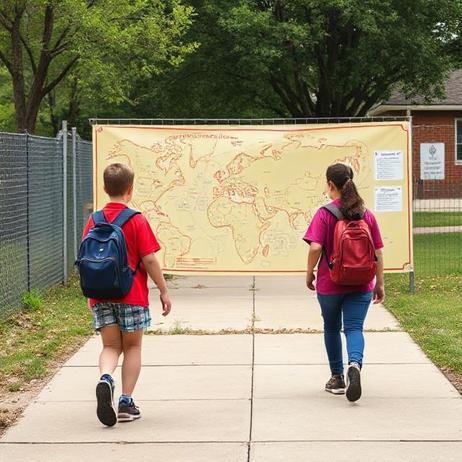Public School Boundaries and Equity in 2025
Public school boundaries are far more than administrative lines—they are powerful levers that shape who gets access to quality education, which communities benefit or suffer, and how equitable opportunities will be in the decade ahead. In 2025, as districts across the United States grapple with demographic shifts, funding challenges, and rising scrutiny of equity, the way boundaries are drawn and redrawn is under renewed attention.
This article retains the original framework—defining boundaries, exploring their impact, reviewing trends and challenges, and proposing strategies—but updates data, policies, and real‐world examples through a 2025 lens.
What Are Public School Boundaries?
Public school boundaries, also known as attendance zones or enrollment zones, are the geographic lines drawn by school districts that determine which public school a student will attend based on their address. They serve multiple functions:
Assign students to schools to manage enrollment and capacity
Reflect district priorities in transportation, community cohesion, and resource allocation
Implicitly influence demographics, socioeconomic balance, and access to programs
In practice, boundaries act as gatekeepers: who can walk, who must bus, and which students gain access to high-performing schools or specialized programs.
How School Districts Draw Boundaries—and Why That Matters
Districts typically use a mix of factors when establishing or adjusting boundaries:
Population density and growth projections — to anticipate where demand will rise
School capacity and utilization — to avoid overcrowding or underuse
Neighborhood and municipal lines — for simplicity, though not always optimal for equity
Feeder patterns and transitions — aligning elementary, middle, and high schools for continuity
Equity goals — incorporating racial, socioeconomic, or linguistic diversity considerations
In 2025, many districts explicitly include equity metrics—such as percentage of students eligible for free or reduced-price lunch, racial composition, and English learner populations—as boundary criteria.
For example, Howard County, Maryland, initiated a 2025 boundary review to address schools functioning at over 110 percent capacity. The district incorporated demographic balance and continuity in feeder patterns as decision levers. hcpss.org
However, the process remains complex, because every adjustment carries trade-offs in transportation, community disruption, and political pushback.
Why Public School Boundaries Matter for Equity Reinforcing or Reducing Segregation
School boundaries often mirror residential segregation. Over time, that can entrench racial and socioeconomic divides inside schools themselves.
A seminal analysis estimated 2,373 “highly racially unequal” boundary lines across U.S. metropolitan areas—suggesting that boundary design continues to contribute to segregation.
Even modest boundary tweaks can either aggravate or ameliorate such divides. Researchers have proposed novel strategies—like merging school zones or using optimization algorithms—that can reduce racial/ethnic segregation by 20 percent or more across large districts, with relatively minor increases in travel time. arXiv+1
Disparities in Resources and Programs
The lines drawn on a map influence which schools receive how much local revenue (largely derived from property taxes), how many students attend, and what programs a school can sustain.
A cross‐district study found that predominantly White districts neighboring more diverse ones collected on average $2,222.70 more per pupil in local revenue. Maps.com
Federal data from the Civil Rights Data Collection also reflect persistent disparities in access to advanced coursework, library resources, and experienced teachers in lower-income attendance zones.
Stability, Community, and Student Experience
Boundary changes affect students’ social networks, continuity, and emotional well-being. Reassigning students mid-school career can disrupt peer ties, extracurricular participation, and sense of belonging.
Moreover, frequent redistricting can breed distrust in district leadership and amplify inequities in community voice and power.
Trends, Innovations, and Challenges in 2025 Algorithmic Redistricting & Optimization
In 2025, researchers are deploying multi-objective optimization frameworks that weigh equity, transportation cost, feeder continuity, and community preferences. One recent model allowed districts to optimize across these dimensions while exposing trade-offs in boundary decisions.
Another project, BoundarEase, is a web-based platform designed to foster more participatory, transparent boundary planning. It helps community members explore proposed boundary maps, simulate impacts, and weigh trade-offs collectively.
These tools promise to move boundary planning beyond back-room mapmaking toward style="line-height:1.38;margin-top:12pt;margin-bottom:2pt;">Data-Driven Equity Indicators
To support more equitable boundary decisions, district leaders are embracing richer data systems. For instance, a recent workshop through Teachers College’s CALL-MEI initiative empowered principals to embed equity indicators into their decision-making dashboards, including student performance gaps, mobility rates, and resource access.
By integrating these indicators, districts can simulate the consequences of boundary tweaks ahead of implementation—not simply by geography, but by impact.
Mounting Political PressuresPublic debates over diversity, DEI (diversity, equity, and inclusion), and school choice increasingly influence how boundary changes are received. In 2025, the U.S. Department of Education launched a public portal for complaints about DEI initiatives in K–12 schools, reflecting heightened scrutiny of affirmative equity policies.
In parallel, states such as Texas are passing sweeping voucher laws that may redirect public funds to private schools, intensifying pressure on public district planning and equity.
Districts must navigate these political currents while staying focused on equitable student access.
The Strain of UnderfundingWhile boundary redrawing can shift students, it does not eliminate structural underfunding. The 2025 report on state school finance systems emphasizes that many states still struggle to equalize funds across districts serving high-poverty areas.
Even with more equitable boundaries, under-resourced schools may struggle to match offerings in wealthier zones—limiting the impact of redistricting alone.
Strategies for More Equitable Boundary PolicyAdopt clear equity principles up front
Districts should articulate how diversity, socioeconomic balance, and resource access figure into boundary decisions. Transparent criteria build legitimacy.Use participatory mapping tools
Tools like BoundarEase help stakeholders visualize trade-offs and engage more thoughtfully.Run scenario modeling with equity metrics
Simulate multiple redrawing options and assess impacts on key indicators (e.g. racial mix, travel time, feeder disruption). Optimization methods make trade-off space clearer.Limit student disruption through phased transitions
When possible, grandfather cohorts to their current schools and limit reassignments. Prioritize minimizing mid-career transfers.Pair boundary reform with resource investment
To make boundary changes meaningful, districts must invest in under-resourced schools—improving facilities, staffing, and program offerings.Institutionalize equity dashboards
Regularly monitor disparities in funding, performance, course access, and student mobility to guide future planning. The CALL-MEI and similar data systems offer models.Address housing and zoning policy
Long-term equity depends on breaking the link between neighborhood wealth and school opportunities. Local land use and housing policies can desegregate zones over time.
Howard County, MD
In its 2025 boundary review, the district considered multiple scenarios that redistributed ~400 students to reduce overcapacity, preserve feeder alignment, and add demographic balance. Public meetings informed final decisions.Large-scale academic partnerships
In partnership with a major U.S. district serving 50,000+ students, researchers applied an optimization framework that produced plans improving socioeconomic integration without undue increases in travel.System mergers vs. boundary tweaks
In districts with many adjacent schools in racially disparate areas, merging attendance zones—rather than just redrawing lines—has shown potential to reduce segregation more deeply.Community engagement innovations
BoundarEase and similar platforms are being piloted to reduce polarization in public input by making boundary trade-offs more tangible to neighbors with different stakes.
Boundary reform in 2025 is not just a technical exercise—it’s a test of districts’ commitment to fairness, transparency, and community trust. As political pressures shift, districts that proactively embed equity in mapping, engage stakeholders sincerely, and align policy with funding will be best positioned to offer truly accessible, high-quality public education.
For families, educators, and policymakers navigating boundary debates, here’s a guiding principle: lines on maps should be provisional tools, not immutable barriers. Where boundaries must change, the process can promote—not undermine—equity.














